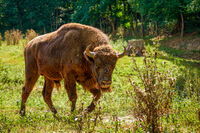Wisent
| Wisent | |
|---|---|

| |
| Scientific classification | |
| Kingdom Information | |
| Domain | Eukaryota |
| Kingdom | Animalia |
| Subkingdom | Bilateria |
| Branch | Deuterostomia |
| Phylum Information | |
| Phylum | Chordata |
| Sub-phylum | Vertebrata |
| Infraphylum | Gnathostomata |
| Class Information | |
| Class | Mammalia |
| Sub-class | Theriiformes |
| Infra-class | Holotheria |
| Order Information | |
| Superorder | Preptotheria |
| Order | Artiodactyla |
| Family Information | |
| Family | Bovidae |
| Sub-family | Bovinae |
| Genus Information | |
| Genus | Bison |
| Species Information | |
| Species | B. bonasus |
| Subspecies | B. b. bonasus B. b. caucasicus |
| Population statistics | |
| Population | 1,800 (2006) |
| Conservation status | Threatened[1] |
The wisent or European bison (Bison bonasus), is the largest living land mammal in Europe, and a relative of the American bison. At one time nearly extinct, the wisent has made a small comeback through careful breeding of captive individuals, small reintroductions to the wild, and intensive conservation management.
Description
The wisent stands between 5 and 7 feet at the shoulder, and weighs up to 2,000 pounds. Body length is just over 10 feet, excluding the tail. The color of the animal is a uniform brown throughout. The extinct subspecies B. b. caucasicus was slightly smaller, with a warm sepia color to the coat.
The wisent differs from its American relative in having a leaner look; the shoulder hump is less-pronounced, giving the back an almost straight appearance. The tail is longer and hangs down to below the fetlocks, while the body hair is shorter; in the American bison there is a well-defined dark shaggy area forward of the chest, something the wisent lacks.